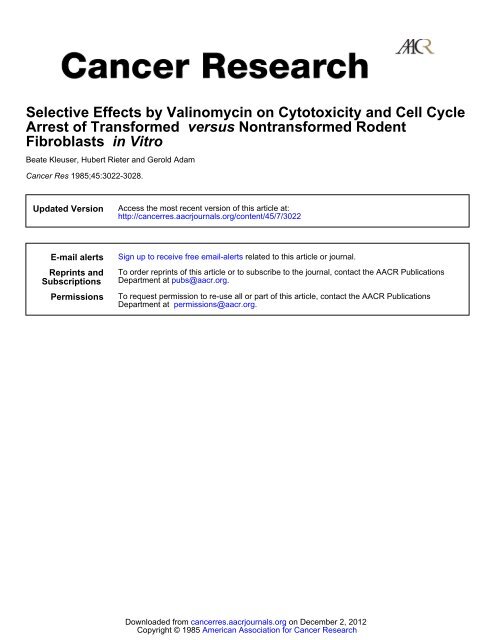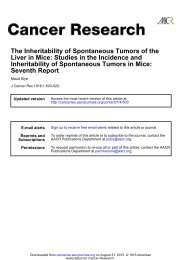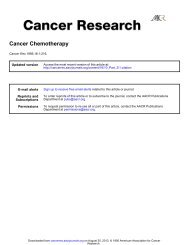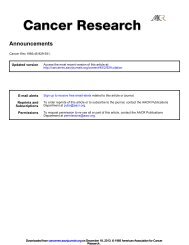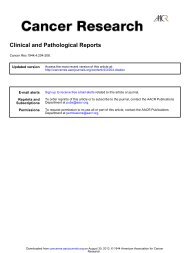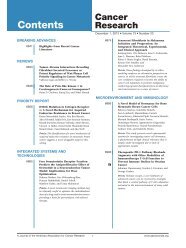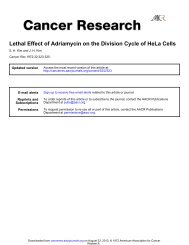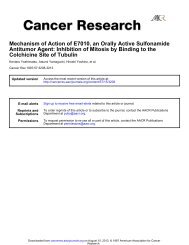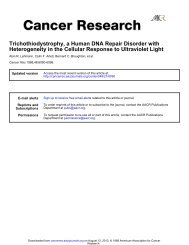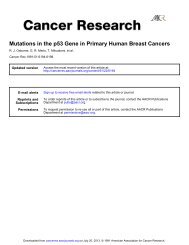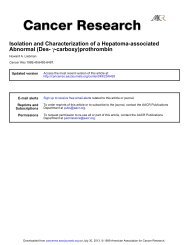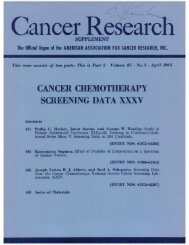Selective Effects by Valinomycin on Cytotoxicity ... - Cancer Research
Selective Effects by Valinomycin on Cytotoxicity ... - Cancer Research
Selective Effects by Valinomycin on Cytotoxicity ... - Cancer Research
You also want an ePaper? Increase the reach of your titles
YUMPU automatically turns print PDFs into web optimized ePapers that Google loves.
<str<strong>on</strong>g>Selective</str<strong>on</strong>g> <str<strong>on</strong>g>Effects</str<strong>on</strong>g> <str<strong>on</strong>g>by</str<strong>on</strong>g> <str<strong>on</strong>g>Valinomycin</str<strong>on</strong>g> <strong>on</strong> <strong>Cytotoxicity</strong> and Cell Cycle<br />
Arrest of Transformed versus N<strong>on</strong>transformed Rodent<br />
Fibroblasts in Vitro<br />
Beate Kleuser, Hubert Rieter and Gerold Adam<br />
<strong>Cancer</strong> Res 1985;45:3022-3028.<br />
Updated Versi<strong>on</strong><br />
Access the most recent versi<strong>on</strong> of this article at:<br />
http://cancerres.aacrjournals.org/c<strong>on</strong>tent/45/7/3022<br />
E-mail alerts Sign up to receive free email-alerts related to this article or journal.<br />
Reprints and<br />
Subscripti<strong>on</strong>s<br />
Permissi<strong>on</strong>s<br />
To order reprints of this article or to subscribe to the journal, c<strong>on</strong>tact the AACR Publicati<strong>on</strong>s<br />
Department at pubs@aacr.org.<br />
To request permissi<strong>on</strong> to re-use all or part of this article, c<strong>on</strong>tact the AACR Publicati<strong>on</strong>s<br />
Department at permissi<strong>on</strong>s@aacr.org.<br />
Downloaded from<br />
cancerres.aacrjournals.org <strong>on</strong> December 2, 2012<br />
Copyright © 1985 American Associati<strong>on</strong> for <strong>Cancer</strong> <strong>Research</strong>
[CANCER RESEARCH 45, 3022-3028, July 1985]<br />
<str<strong>on</strong>g>Selective</str<strong>on</strong>g> <str<strong>on</strong>g>Effects</str<strong>on</strong>g> <str<strong>on</strong>g>by</str<strong>on</strong>g> <str<strong>on</strong>g>Valinomycin</str<strong>on</strong>g> <strong>on</strong> <strong>Cytotoxicity</strong> and Cell Cycle Arrest of<br />
Transformed versus N<strong>on</strong>transformed Rodent Fibroblasts in Vitro1<br />
Beate Kleuser, Hubert Rieter, and Gerold Adam2<br />
Fakultättur Biologie, UniversitätK<strong>on</strong>stanz, D-7750 K<strong>on</strong>stanz, Federal Republic of Germany<br />
ABSTRACT<br />
The effect of submicromolar c<strong>on</strong>centrati<strong>on</strong>s of the K+ i<strong>on</strong>o-<br />
phore valinomycin <strong>on</strong> proliferati<strong>on</strong>, viability, distributi<strong>on</strong> of cell<br />
populati<strong>on</strong> over phases of the cell cycle, and cellular adenosine<br />
triphosphate c<strong>on</strong>tent of different permanent rodent cell lines in<br />
vitro was investigated. <str<strong>on</strong>g>Valinomycin</str<strong>on</strong>g> inhibits proliferati<strong>on</strong> of all cell<br />
lines tested with a saturating effect at about 20 to 100 nw. The<br />
effect of valinomycin <strong>on</strong> n<strong>on</strong>transformed 3T3 mouse and Rat-1<br />
cells is n<strong>on</strong>toxic, whereas it acts with increasing toxicity <strong>on</strong> the<br />
transformed cells in the order 3T6 mouse, polyoma-3T3 mouse,<br />
temperature-sensitively Rous sarcoma virus-transformed Rat-1<br />
at permissive temperature, and SV40-3T3 cells. According to<br />
these and some other criteria, the essential acti<strong>on</strong> of valinomycin<br />
appears to be to impose <strong>on</strong> the cells at low growth densities a<br />
state of limiting growth c<strong>on</strong>diti<strong>on</strong> which normally is encountered<br />
<strong>on</strong>ly at high cell densities and/or low serum c<strong>on</strong>centrati<strong>on</strong>.<br />
N<strong>on</strong>transformed cells are proliferati<strong>on</strong> arrested <str<strong>on</strong>g>by</str<strong>on</strong>g> valinomycin<br />
essentially in the G, phase of the cell cycle, whereas all trans<br />
formed cells under this c<strong>on</strong>diti<strong>on</strong> are not arrested selectively in<br />
G,. In all cell lines tested (3T3, 3T6, and SV40-3T3), cellular<br />
adenosine triphosphate c<strong>on</strong>tent is decreased <str<strong>on</strong>g>by</str<strong>on</strong>g> about 33% up<strong>on</strong><br />
treatment with 20 nw valinomycin. Evidence is presented for a<br />
mitoch<strong>on</strong>drial site of acti<strong>on</strong> of valinomycin.<br />
INTRODUCTION<br />
It is well known that untransformed cells, up<strong>on</strong> encountering<br />
limiting growth c<strong>on</strong>diti<strong>on</strong>s, shift reversibly into a quiescent state<br />
of proliferati<strong>on</strong> with a Gìequivalent of DNA ("restricti<strong>on</strong> point<br />
c<strong>on</strong>trol"), whereas cells transformed <str<strong>on</strong>g>by</str<strong>on</strong>g> DNA viruses generally<br />
are arrested in all phases of the cell cycle and eventually die (1-<br />
4). Exploitati<strong>on</strong> <str<strong>on</strong>g>by</str<strong>on</strong>g> reinforcement of such differences of prolifer<br />
ati<strong>on</strong> behavior between transformed and normal cells appeared<br />
promising in attempts to devise procedures selectively toxic for<br />
tumor cells (4-6). However, subsequent work dem<strong>on</strong>strated that<br />
various transformed cell lines differ widely with respect to the<br />
effect of serum deficiency or drug treatment <strong>on</strong> cell growth and/<br />
or phase of cell cycle in which proliferati<strong>on</strong> arrest occurs (5, 6).<br />
In particular, sp<strong>on</strong>taneously, chemically, or RNA virus-trans<br />
formed cell lines appear to be arrested predominantly in G, phase<br />
up<strong>on</strong> serum reducti<strong>on</strong> (5). In our search for an agent innocuous<br />
for normal cells but affecting selectively the proliferative state of<br />
transformed cells in general, interference with the energized state<br />
of the mitoch<strong>on</strong>dria appeared most promising because it deter<br />
mines both ATP level (7) and calcium homeostasis of the cell (8).<br />
This directi<strong>on</strong> of proceeding is str<strong>on</strong>gly supported <str<strong>on</strong>g>by</str<strong>on</strong>g> recent<br />
findings <strong>on</strong> the selective cytotoxicity of the cati<strong>on</strong>ic dye rhoda-<br />
' Supported <str<strong>on</strong>g>by</str<strong>on</strong>g> grants from Stiftung Volkswagenwerk (Schwerpunkt Synergetik)<br />
and Deutsche Forschungsgemeinschaft (S<strong>on</strong>derforschungsbereich 156).<br />
2 To whom requests for reprints should be addressed.<br />
Received 12/26/84; revised 3/18/85; accepted 4/4/85.<br />
mine 123 <strong>on</strong> carcinoma cells (9,10). This compound is retained<br />
tightly <str<strong>on</strong>g>by</str<strong>on</strong>g> the mitoch<strong>on</strong>dria of transformed but not of n<strong>on</strong>trans<br />
formed epithelial cells (11). However, it is not retained significantly<br />
<str<strong>on</strong>g>by</str<strong>on</strong>g> transformed or n<strong>on</strong>transformed fibroblasts (11). Corresp<strong>on</strong>d<br />
ingly, we have not detected significant inhibitory effects <strong>on</strong> the<br />
proliferati<strong>on</strong> of SV40-3T3 cells.3<br />
The macrocyclic i<strong>on</strong>ophore VAL4 at submicromolar c<strong>on</strong>centra<br />
ti<strong>on</strong> is known to dissipate the mitoch<strong>on</strong>drial transmembrane<br />
potential (12-14) and there<str<strong>on</strong>g>by</str<strong>on</strong>g> to affect functi<strong>on</strong>s depending <strong>on</strong><br />
this, such as ADP-ATP translocati<strong>on</strong> (15), calcium fluxes (16),<br />
and, under certain c<strong>on</strong>diti<strong>on</strong>s, oxidative phosphorylati<strong>on</strong> (12-14,<br />
17). In line with our present approach, VAL at submicromolar<br />
c<strong>on</strong>centrati<strong>on</strong>s was found to inhibit DNA synthesis in chicken<br />
embryo fibroblasts (18) and, furthermore, was reported in a brief<br />
summary to exhibit antitumor activity in tests in vivo (19, 20).<br />
We have therefore investigated the effect of VAL <strong>on</strong> cellular<br />
proliferati<strong>on</strong> for a spectrum of transformed and n<strong>on</strong>transformed<br />
rodent fibroblasts. We will show in the following that VAL arrests<br />
n<strong>on</strong>transformed rodent fibroblasts in Gìbut various transformed<br />
fibroblasts n<strong>on</strong>selectively with respect to d. Furthermore, it is<br />
shown that VAL renders virus-transformed cells at low cell<br />
densities to enter a state leading to cell death after 1 to 2 days,<br />
whereas it is reversibly cytostatic for n<strong>on</strong>transformed fibroblasts<br />
and for a sp<strong>on</strong>taneously transformed line (3T6 cells). Preliminary<br />
accounts of part of this work appeared previously (21, 22).<br />
MATERIALS AND METHODS<br />
CANCER RESEARCH VOL. 45 JULY 1985<br />
3022<br />
Cell Cultures. Swiss 3T3 and 3T6 cells were obtained from Flow<br />
Laboratories (B<strong>on</strong>n, Federal Republic of Germany). SV40 virus-trans<br />
formed Swiss 3T3 cells (SV40-3T3, line 101) and polyoma virus-trans<br />
formed Swiss 3T3 cells (PY-3T3) were kindly provided <str<strong>on</strong>g>by</str<strong>on</strong>g> Dr. M. M.<br />
Burger, Basel, Switzerland. Fisher F2408 (Rat-1) rat cells and Rat-1 cells<br />
transformed <str<strong>on</strong>g>by</str<strong>on</strong>g> mutant ts LA334m of strain B77 of Rous sarcoma virus<br />
(ts RSV-Rat-1) were kindly given <str<strong>on</strong>g>by</str<strong>on</strong>g> Dr. J. Wyke, L<strong>on</strong>d<strong>on</strong>, England. Stock<br />
cultures of these cells were maintained in plastic dishes (Greiner, Nürtingen,<br />
Federal Republic of Germany) with antibiotic-free Dulbecco's mod<br />
ificati<strong>on</strong> of Eagle's medium (Flow Laboratories) c<strong>on</strong>taining 5% heat-<br />
inactivated NBCS (Gibco Europe, Glasgow, Scotland) at 37°C and a<br />
humidified atmosphere of 10% CO2 in air. N<strong>on</strong>transformed cells were<br />
passaged at subc<strong>on</strong>fluency, and transformed cells were passaged after<br />
c<strong>on</strong>fluency, 3 times weekly <str<strong>on</strong>g>by</str<strong>on</strong>g> splitting about 5:1. After about 40 pas<br />
sages, cells were renewed from frozen stocks.<br />
Experimental cultures and c<strong>on</strong>trols were grown as described above,<br />
except that penicillin and streptomycin (each 30 M9/ml) was added and<br />
the medium was renewed daily. The ts RSV-Rat-1 cells were grown at<br />
35°C in medium c<strong>on</strong>taining fetal calf serum, buffered with 20 mw W-2-<br />
hydroxyethylpiperazine-AT-2-ethane-sulf<strong>on</strong>ic acid, and sodium bicarb<strong>on</strong><br />
ate (0.6 mg/ml), and maintaining the atmosphere at 2% CO2 in air. The<br />
3 Unpublished observati<strong>on</strong>s.<br />
4 The abbreviati<strong>on</strong>s used are: VAL, valinomycin; NBCS, newborn calf serum; ts<br />
RSV-Rat-1, Rat-1 cells temperature-sensitively transformed <str<strong>on</strong>g>by</str<strong>on</strong>g> mutant LA334m of<br />
Rous sarcoma virus strain B77.<br />
Downloaded from<br />
cancerres.aacrjournals.org <strong>on</strong> December 2, 2012<br />
Copyright © 1985 American Associati<strong>on</strong> for <strong>Cancer</strong> <strong>Research</strong>
procedures for seeding and Coulter counting of the experimental cultures<br />
were as described previously (23), yielding cell densities of parallel plates<br />
reproducible within 5 to 10%. All the data given are averages from<br />
duplicate plates. VAL was obtained from Serva, Heidelberg, Federal<br />
Republic of Germany, and was applied from a 20 ,UMstock soluti<strong>on</strong> in<br />
ethanol, keeping the ethanol c<strong>on</strong>centrati<strong>on</strong> in the medium below 0.1%.<br />
C<strong>on</strong>trols were treated equally, but without VAL.<br />
Cell Cycle Analysis. Fracti<strong>on</strong>s of cells in different phases of the cell<br />
cycle were determined flow cytometrically <str<strong>on</strong>g>by</str<strong>on</strong>g> the fluorescence of the<br />
DNA-specific bisbenzimide stain Hoechst 33258, using the impulse cy-<br />
tophotometer ICP22 (Biophysics Systems, Bensheim, Federal Republic<br />
of Germany) as described previously (23). Cells were trypsinized, fixed<br />
for 15 min in 50% ethanol, and stained for 10 min in Hoechst 33258 (8<br />
¿ig/ml).The DNA histogram was evaluated graphically in terms of the<br />
relative fracti<strong>on</strong> GiM of cells with a Gìequivalent of DNA, defined as the<br />
ratio of the area of the Gìpeak to the total area of the fluorescence<br />
histogram. For separati<strong>on</strong> of the area of the d peak in the regi<strong>on</strong> of<br />
overlap with the S-phase area of the histogram, the criteria given in (24)<br />
were applied, allowing, if necessary, for skewed S-phase distributi<strong>on</strong>s<br />
<str<strong>on</strong>g>by</str<strong>on</strong>g> n<strong>on</strong>horiz<strong>on</strong>tal extrapolati<strong>on</strong> of the S-phase area up to the abscissa of<br />
the G! maximum.<br />
Determinati<strong>on</strong> of Cellular ATP. Cellular levels of ATP were deter<br />
mined <str<strong>on</strong>g>by</str<strong>on</strong>g> the luciferin-luciferase assay. Cells were scraped off the plate<br />
with a rubber policeman and suspended in 5 ml calcium-magnesium-free<br />
phosphate-buffered saline c<strong>on</strong>taining 1 mw EDTA. A volume of 0.1 to<br />
0.2 ml of this cell suspensi<strong>on</strong> was added to 0.6 ml of distilled boiling<br />
water and heated for 10 min in a boiling water bath. Cellular ATP was<br />
measured in a luminometer (Luminometer 1250; LKB, Gräfelfing,Federal<br />
Republic of Germany) after adding a 10- to 1OÛ-M!aliquot of this soluti<strong>on</strong><br />
to a volume of 200 n\ reagent soluti<strong>on</strong> of the luciferin-luciferase system<br />
(ATP Bioluminescence CLS; Boehringer, Mannheim, Federal Republic of<br />
Germany). Measurements were calibrated <str<strong>on</strong>g>by</str<strong>on</strong>g> adding 5 ^l of a standard<br />
with known ATP c<strong>on</strong>centrati<strong>on</strong>.<br />
RESULTS<br />
Effect of VAL <strong>on</strong> Proliferati<strong>on</strong> and Viability. The effect of<br />
VAL <strong>on</strong> the proliferati<strong>on</strong> and viability of different normal and<br />
transformed cell lines is shown in Charts 1 to 9. In all these<br />
experiments, cells were seeded at a density of 1000 to 3000/sq<br />
Chart 1. Effect of VAL <strong>on</strong> proliferati<strong>on</strong> and viability of 3T3 cells maintainedwith<br />
daily medium renewals c<strong>on</strong>taining NBCS. O, untreated c<strong>on</strong>trol (5% NBCS);•, cells<br />
during daily applicati<strong>on</strong> of 20 nw VAL (5% NBCS); A, cells after VAL treatment,<br />
maintainedwith 5% NBCS; A, same with 20% NBCS; •cells after VAL treatment<br />
reseeded at 5% NBCS. Top, density of cells adhering to the plates; bottom,<br />
percentage of cells released into the supernatant medium since the last renewal<br />
relative to the number of adhering cells; abscissa, time of growth in days (t/d).<br />
GROWTH INHIBITION AND CYTOTOXICITY BY VAL<br />
CANCER RESEARCH VOL 45 JULY 1985<br />
3023<br />
Chart 2. Effect of VAL <strong>on</strong> proliferati<strong>on</strong>and viabilityof SV40-3T3cells maintained<br />
with daily medium renewals c<strong>on</strong>taining NBCS. O, untreated c<strong>on</strong>trols (5% NBCS);<br />
».cells during daily applicati<strong>on</strong> of 20 ni«VAL (5% NBCS); A, cells after VAL<br />
treatment maintainedwith 5% NBCS; A, same at 20% NBCS; •cells after VAL<br />
treatment reseeded at 5% NBCS. Top, density of cells adhering to the plates;<br />
bottom, percentage of cells released into the supernatant medium since the last<br />
renewal relative to the number of adhering cells; abscissa, time of growth in days<br />
(t/d).<br />
cm in Dulbecco's modificati<strong>on</strong> of Eagle's medium c<strong>on</strong>taining 5%<br />
NBCS and maintained with daily medium renewals. From the<br />
time indicated <str<strong>on</strong>g>by</str<strong>on</strong>g> the first arrow until the time indicated <str<strong>on</strong>g>by</str<strong>on</strong>g> a<br />
sec<strong>on</strong>d arrow (whenever this occurs), VAL was applied daily at<br />
20 nw (except in the experiments shown <strong>on</strong> Charts 3, 7, and 8,<br />
where variant c<strong>on</strong>centrati<strong>on</strong>s of VAL were used). In all cases,<br />
proliferati<strong>on</strong> of the treated populati<strong>on</strong>s is completely arrested<br />
after about 2 days of severely slowed-down growth. Even at a<br />
c<strong>on</strong>centrati<strong>on</strong> as low as 2 nw, there is substantial inhibiti<strong>on</strong> of<br />
proliferati<strong>on</strong> as shown in Chart 7 for 3T6 cells (similar data were<br />
obtained for 3T3 and SV40-3T3 cells, not shown).<br />
Toxic effects of VAL <strong>on</strong> the cell lines investigated are indicated<br />
<str<strong>on</strong>g>by</str<strong>on</strong>g> decreases of cell densities with time. In additi<strong>on</strong>, we have<br />
determined <str<strong>on</strong>g>by</str<strong>on</strong>g> Coulter counter the number of cells per nuclei<br />
released into the medium during the 1-day interval since the last<br />
medium exchange. These data are plotted in the lower parts of<br />
Charts 1 to 4 as a percentage of cells in the supernatant medium<br />
relative to adhering cells, and they agree well with corresp<strong>on</strong>ding<br />
decreases of numbers of (adhering) cells given in the upper parts<br />
of these charts. At 20 to 100 nv VAL, there is little effect <strong>on</strong> the<br />
viability of 3T3, 3T6, and Rat-1 cells (Charts 1, 3, 5, 7, and 8).<br />
Inhibiti<strong>on</strong> of proliferati<strong>on</strong> <str<strong>on</strong>g>by</str<strong>on</strong>g> VAL in these cells is reversible after<br />
a certain time lag, as shown <str<strong>on</strong>g>by</str<strong>on</strong>g> disc<strong>on</strong>tinuing the VAL treatment<br />
after 3 days and applying fresh medium c<strong>on</strong>taining 5% or 20%<br />
NBCS with daily medium renewal (Charts 1 and 3). The lag time<br />
of recovery of proliferati<strong>on</strong> is somewhat shorter, when cells are<br />
trypsinized and reseeded at lower cell density into fresh medium<br />
c<strong>on</strong>taining 5% NBCS (Charts 1 and 3). Essentially all of the cells<br />
n<strong>on</strong>toxically exposed to VAL will resume proliferati<strong>on</strong> after 2-5<br />
Downloaded from<br />
cancerres.aacrjournals.org <strong>on</strong> December 2, 2012<br />
Copyright © 1985 American Associati<strong>on</strong> for <strong>Cancer</strong> <strong>Research</strong>
GROWTH INHIBITION AND CYTOTOXICITY BY VAL<br />
Chart 3. Effect of VAL <strong>on</strong> proliferati<strong>on</strong> and viability of Rat-1 cells maintained<br />
with daily medium renewals c<strong>on</strong>taining NBCS. O, untreated c<strong>on</strong>trol (5% NBCS); •,<br />
cells during daily applicati<strong>on</strong> of 100 nM VAL (5% NBCS); A, cells after VAL treatment<br />
(5% NBCS); A, same at 20% NBCS; D, cells after VAL treatment reseeded at 5%<br />
NBCS. Top. density of cells adhering to the plates; bottom, percentage of cells<br />
released into the supernatant medium since the last renewal relative to the number<br />
of adhering cells; abscissa, time of growth in days (t/d).<br />
days under these c<strong>on</strong>diti<strong>on</strong>s, as was ascertained for 3T3 and<br />
3T6 cells <str<strong>on</strong>g>by</str<strong>on</strong>g> the 5-bromodeoxyuridine-Hoechst 33528 method<br />
(25); data are not shown here. In c<strong>on</strong>trast, the effect of VAL <strong>on</strong><br />
the DNA and RNA virus-transformed cell lines (SV40-3T3 and ts<br />
RSV-Rat-1 at permissive temperature) is str<strong>on</strong>gly cytotoxic<br />
(Charts 2, 4, and 9, broken curves). This toxic effect c<strong>on</strong>tinues<br />
for >7 days, even if the VAL treatment is replaced <str<strong>on</strong>g>by</str<strong>on</strong>g> daily<br />
applicati<strong>on</strong> of fresh medium c<strong>on</strong>taining 5% or 20% NBCS (Charts<br />
2 and 4, solid curves after sec<strong>on</strong>d arrow). Recovery in the<br />
medium with a higher c<strong>on</strong>centrati<strong>on</strong> of NBCS (20%) turns out to<br />
be more efficient (less cell death) and faster. Interestingly, recov<br />
ery after reseeding into fresh medium at lower cell density<br />
appreciably alleviates cell loss but still requires 4 to 5 days<br />
(Charts 2 and 4).<br />
Phases of Cell Cycle of VAL-induced Inhibiti<strong>on</strong> of Prolifer<br />
ati<strong>on</strong>. Normal cells are arrested in G,. when proliferati<strong>on</strong>is limited<br />
<str<strong>on</strong>g>by</str<strong>on</strong>g> serum factors and/or cell density (cf. c<strong>on</strong>trols in Charts 5 and<br />
8). However, there are sp<strong>on</strong>taneously, chemically, or RNA virus-<br />
transformed cell lines which are also arrested in d phase, if<br />
growth c<strong>on</strong>diti<strong>on</strong>s are limiting. An example of this behavior is<br />
3T6 cells (see c<strong>on</strong>trol in Chart 7). It has therefore been of interest<br />
whether the extent of cytotoxicity of VAL correlates with the<br />
phase of cell cycle of VAL-induced growth arrest. We have<br />
determined histograms of cellular DNA c<strong>on</strong>tents <str<strong>on</strong>g>by</str<strong>on</strong>g> flow cytometry,<br />
as described in "Materials and Methods," and evaluated the<br />
relative fracti<strong>on</strong> G1wof cells with a d equivalent of cellular DNA.<br />
This quantity is plotted in parallel to cellular populati<strong>on</strong> dynamics<br />
10<br />
106<br />
20<br />
Chart 4. Effect of VAL <strong>on</strong> proliferati<strong>on</strong> and viability of Rat-1 cells transformed<br />
<str<strong>on</strong>g>by</str<strong>on</strong>g> ts RSV-Rat-1 at permissive temperature (35°C)maintained with daily medium<br />
renewals c<strong>on</strong>taining fetal calf serum. O, untreated c<strong>on</strong>trols (5% fetal calf serum);<br />
•,cells during daily applicati<strong>on</strong> of 20 nM VAL (5% fetal calf serum); A, cells after<br />
VAL treatment maintained at 5% fetal calf serum; A, same at 20% fetal calf serum;<br />
•,cells after VAL treatment reseeded at 5% fetal calf serum. Top, density of cells<br />
adhering to the plates; bottom, percentage of cells released into the supernatant<br />
medium since the last renewal relative to the number of adhering cells; abscissa,<br />
time of growth in days (f/d).<br />
0.65<br />
CANCER RESEARCH VOL. 45 JULY 1985<br />
Chart 5. Effect of daily applicati<strong>on</strong> of 20 nM VAL in fresh medium c<strong>on</strong>taining 5%<br />
NBCS <strong>on</strong> density ((op) of 3T3 cells and their relative fracti<strong>on</strong> G,ra with G, equivalent<br />
of DNA (bottom). Abscissa, time of growth in days (f/o). •,untreated c<strong>on</strong>trol; A,<br />
VAL-treated cells.<br />
3024<br />
Downloaded from<br />
cancerres.aacrjournals.org <strong>on</strong> December 2, 2012<br />
Copyright © 1985 American Associati<strong>on</strong> for <strong>Cancer</strong> <strong>Research</strong><br />
10
Chart 6. Effect of daily applicati<strong>on</strong> of 20 DMVAL in fresh medium c<strong>on</strong>taining 5%<br />
NBCS <strong>on</strong> density (fop) of SV40-3T3 cells and their relative fracti<strong>on</strong> G,„,with Gt<br />
equivalent of DMA (bottom). Abscissa, time of growth in days (r/d). •,untreated<br />
c<strong>on</strong>trol; A, VAL-treated cells.<br />
in Charts 5 to 9. Interestingly, all n<strong>on</strong>transformed lines tested<br />
approach a Giw near 1 under the acti<strong>on</strong> of VAL, whereas all<br />
transformed cells tested are not arrested selectively in d if VAL<br />
is applied. The same result was found for PY-3T3 cells (data not<br />
shown). The kinetics of transiti<strong>on</strong> of VAL-treated cells through<br />
the cell cycle is different for different cells. Chart 5 shows that<br />
3T3 cells during 2 to 3 days after applicati<strong>on</strong> of VAL gradually<br />
run through the cell cycle and slowly accumulate in G,, whereas<br />
the transit of Rat-1 cells through the cycle under these c<strong>on</strong>di<br />
ti<strong>on</strong>s, albeit <strong>on</strong>ly for a fracti<strong>on</strong> of the populati<strong>on</strong>, occurs faster<br />
(Chart 8). According to Charts 6, 7, and 9, all transformed cells<br />
up<strong>on</strong> VAL treatment do not accumulate selectively in Gì.How<br />
ever, the details of the resulting changes of the DMA histograms<br />
differ somewhat for different transformed cell lines (data not<br />
shown); whereas SV40-3T3 and ts RSV-Rat-1 (35°C)after VAL<br />
treatment accumulate mostly in early S phase, 3T6 and PY-3T3<br />
are arrested in all phases of the cycle but within about 5 days<br />
partly move out of S phase and accumulate prep<strong>on</strong>derantly in<br />
Gìand G:>.<br />
Effect of VAL <strong>on</strong> Cellular ATP C<strong>on</strong>tent. Because a l<strong>on</strong>g-term<br />
effect of VAL <strong>on</strong> cellular potassium c<strong>on</strong>tent cannot be observed<br />
at the doses applied here (21), mitoch<strong>on</strong>dria! uncoupling might<br />
be the basis of its proliferati<strong>on</strong>-inhibiting effect. We have there<br />
fore determined the effect of VAL <strong>on</strong> cellular ATP c<strong>on</strong>tents of<br />
normal and transformed mouse cells. Results for 3T3 (3 inde<br />
pendent experiments), 3T6, and SV40-3T3 cells (2 independent<br />
experiments each) are shown in Table 1. Every determinati<strong>on</strong><br />
was made in duplicate. Untreated c<strong>on</strong>trols within experimental<br />
error were indistinguishable at the time of VAL applicati<strong>on</strong> and<br />
24 h thereafter; these data were therefore lumped together and<br />
given as c<strong>on</strong>trol. According to the data given in Table 1, the<br />
cellular ATP c<strong>on</strong>tent of normal and transformed cells is lowered<br />
GROWTH INHIBITION AND CYTOTOXICITY BY VAL<br />
0.75<br />
0.25<br />
CANCER RESEARCH VOL. 45 JULY 1985<br />
3025<br />
Chart 7. Effect of daily applicati<strong>on</strong> of VAL in fresh medium c<strong>on</strong>taining 5% NBCS<br />
<strong>on</strong> density (top) of 3T6 cells and their relative fracti<strong>on</strong> G,,„with G, equivalent of<br />
DMA (bottom). Abscissa, time of growth in days (f/d) O, untreated c<strong>on</strong>trol; •,cells<br />
treated with 2 â„¢ VAL; A, cells treated with 20 nu VAL.<br />
Charts. Effect of daily applicati<strong>on</strong> of 100 HM VAL in fresh medium c<strong>on</strong>taining<br />
5% NBCS <strong>on</strong> density ((op) of Rat-1 cells and their relative fracti<strong>on</strong> G,M with Gì<br />
equivalent of DNA (bottom). Abscissa, time of growth in days (tjd). O, untreated<br />
c<strong>on</strong>trol; •.VAL-treated cells.<br />
Downloaded from<br />
cancerres.aacrjournals.org <strong>on</strong> December 2, 2012<br />
Copyright © 1985 American Associati<strong>on</strong> for <strong>Cancer</strong> <strong>Research</strong><br />
10<br />
15
GROWTH INHIBITION AND CYTOTOXICITY BY VAL<br />
10 15<br />
Chart 9. Effect of daily applicati<strong>on</strong> of 20 MMVAL in fresh medium c<strong>on</strong>taining 5%<br />
fetal calf serum <strong>on</strong> density (top) of ts RSV-Rat-1 cells at 35°Cand their relative<br />
fracti<strong>on</strong> G,w with G, equivalent of DNA (bottom). Abscissa, time of growth in days<br />
(f/d). O, untreated c<strong>on</strong>trol; A, VAL-treated cells.<br />
Table 1<br />
Effect of 24-h treatment with VAL <strong>on</strong> cellular ATP c<strong>on</strong>tents<br />
Cells3T3SV40-3T33T6TreatmentC<strong>on</strong>trol20<br />
VALC<strong>on</strong>trol20 nw<br />
VALC<strong>on</strong>trol20 nw<br />
c<strong>on</strong>tent(fmol/cell)5.66<br />
(12f3.84 + 0.82"<br />
(7)3.05 ±0.52<br />
(8)2.23 ±0.27<br />
(4)3.72 ±0.30<br />
nmiVALATP<br />
(7)2.11 ±0.34<br />
±0.20 (4)%<br />
* Average ±SD.<br />
6 Numbers in parentheses, number of determinati<strong>on</strong>s.<br />
of de<br />
creaserelative<br />
toc<strong>on</strong>trol322743<br />
<str<strong>on</strong>g>by</str<strong>on</strong>g> about <strong>on</strong>e-third relative to c<strong>on</strong>trol if 20 nMVAL is applied for<br />
24 h. Cellular ATP c<strong>on</strong>tents 48 h after applicati<strong>on</strong> of 20 nM VAL<br />
(data not shown) within experimental error do not differ from<br />
those at 24 h of exposure.<br />
DISCUSSION<br />
Our present work has shown that daily applicati<strong>on</strong> of VAL at<br />
>2 nM leads to inhibiti<strong>on</strong> of proliferati<strong>on</strong> of all cell lines tested.<br />
This inhibitory effect saturates at about 20 to 100 nw VAL. The<br />
acti<strong>on</strong> of VAL is not cytotoxic to n<strong>on</strong>transformed cells, such as<br />
3T3 and Rat-1, but is cytotoxic to transformed cells with increas<br />
ing impact in the order 3T6, PY-3T3, ts RSV-Rat-1 (35°C),and<br />
SV40-3T3 cells. The low cytotoxic effect <strong>on</strong> 3T6 and PY-3T3 in<br />
c<strong>on</strong>trast to SV40-3T3 cells correlates with their fairly short time<br />
lag of 5 to 20 days for inducti<strong>on</strong> of tumors up<strong>on</strong> inoculati<strong>on</strong> into<br />
nude mice as compared to >80 days for SV40-3T3 cells (26).5<br />
Possibly, the l<strong>on</strong>g latency for tumor development of SV40-3T3<br />
inocula in nude mice results from the death of a majority of the<br />
inoculated SV40-3T3 cell populati<strong>on</strong> before tumor development<br />
starts from a surviving minority of cells.<br />
5 Unpublished data.<br />
If SV40-3T3 cells are grown in vitro to saturating cell densities,<br />
massive cell death is observed after a delay of 1 or 2 days (1, 2,<br />
4). The growth behavior of 3T6 cells is quite different, because<br />
their saturati<strong>on</strong> is reached more gradually, is regulated <str<strong>on</strong>g>by</str<strong>on</strong>g> the<br />
serum c<strong>on</strong>centrati<strong>on</strong>, and does not exhibit substantial cell death.<br />
Similarly, proliferati<strong>on</strong> of 3T6 is inhibited <str<strong>on</strong>g>by</str<strong>on</strong>g> different c<strong>on</strong>centra<br />
ti<strong>on</strong>s of VAL at graduated cell densities and without substantial<br />
cell death (Chart 7). Thus, comparing the growth behavior of<br />
different cell lines with and without VAL, the essential acti<strong>on</strong> of<br />
VAL appears to be to impose <strong>on</strong> the cells at low growth densities<br />
a state of limiting growth c<strong>on</strong>diti<strong>on</strong> which normally is encountered<br />
<strong>on</strong>ly at high cell densities and/or low serum c<strong>on</strong>centrati<strong>on</strong>. This<br />
interpretati<strong>on</strong> can be formulated quantitatively <str<strong>on</strong>g>by</str<strong>on</strong>g> using a simple<br />
populati<strong>on</strong>-dynamic model allowing for <strong>on</strong>ly 2 cellular subpopu<br />
lati<strong>on</strong>s, dividing and l<strong>on</strong>g-term growth-inhibited (quiescent) cells<br />
with a cell density-dependent probability of transiti<strong>on</strong> from the<br />
dividing to the quiescent subpopulati<strong>on</strong> (27, 28). We have shown<br />
earlier that proliferati<strong>on</strong> of 3T3 and SV40-3T3 cells under the<br />
usual in vitro c<strong>on</strong>diti<strong>on</strong>s may thus be described adequately and<br />
that the specific features of SV40-3T3 cells may be accounted<br />
for <str<strong>on</strong>g>by</str<strong>on</strong>g> a somewhat lower transiti<strong>on</strong> probability (about <strong>on</strong>e-fifth<br />
as compared to normal 3T3) to the growth-inhibited state and,<br />
above all, <str<strong>on</strong>g>by</str<strong>on</strong>g> a larger rate c<strong>on</strong>stant (0.5 to 3.0/day) of death of<br />
the growth-inhibited cell populati<strong>on</strong> (27, 28). If the major effect<br />
of saturating c<strong>on</strong>centrati<strong>on</strong>s of VAL is a massive increase of the<br />
probability of transiti<strong>on</strong> to the growth-inhibited state, cells will<br />
accumulate in this state. Then, the rate c<strong>on</strong>stant of overall cell<br />
death is given <str<strong>on</strong>g>by</str<strong>on</strong>g> that of the inhibited cell subpopulati<strong>on</strong> which,<br />
according to Chart 2, is at least 0.6/day in reas<strong>on</strong>able agreement<br />
with the figures for untreated SV40-3T3 cells given above. Even<br />
more detailed features, such as the interplay of cell density and<br />
acti<strong>on</strong> of VAL at different c<strong>on</strong>centrati<strong>on</strong>s (cf. Chart 7), may be<br />
specified quantitatively according to this model.6<br />
Our data <strong>on</strong> the effect of VAL <strong>on</strong> the cellular distributi<strong>on</strong> over<br />
the phases of the cell cycle generally agree with this interpreta<br />
ti<strong>on</strong> but allow for a more detailed characterizati<strong>on</strong> of the mode<br />
of growth arrest. Most significantly, all the n<strong>on</strong>transformed cells<br />
are growth inhibited <str<strong>on</strong>g>by</str<strong>on</strong>g> VAL in Gì, whereas all transformed cells<br />
are inhibited predominantly in S and G2,although some of them<br />
(3T6 and, to a lesser extent, PY-3T3) without VAL are growth<br />
arrested in Gì. This apparently general difference between nor<br />
mal and transformed cells of the cell cycle phase of growth arrest<br />
<str<strong>on</strong>g>by</str<strong>on</strong>g> VAL appears to be relevant for a possible exploitati<strong>on</strong> in<br />
phase-specific selective killingof tumor cells in antitumor therapy.<br />
The cycle phase of growth arrest <str<strong>on</strong>g>by</str<strong>on</strong>g> VAL generally does not<br />
correlate with its cytotoxic effect; e.g., 3T6 cells are arrested in<br />
S and G2 <str<strong>on</strong>g>by</str<strong>on</strong>g> VAL but experience <strong>on</strong>ly relatively little cytotoxic<br />
effect, if compared with SV40-3T3 or ts RSV-Rat-1 (35°C)cells.<br />
According to our still incomplete data, a better correlati<strong>on</strong> is<br />
observed between viability in the presence of VAL and the ability<br />
of cells to down-regulate their rRNA metabolism. We have<br />
observed5 that 3T3, Rat-1, and 3T6 cells under the acti<strong>on</strong> of<br />
VAL exhibit a decrease of cellular rRNA similar to that of the<br />
untreated c<strong>on</strong>trols (23). For 3T6 cells, this result is quite unex<br />
pected, inasmuch as they down-regulate their rRNA metabolism<br />
but are growth arrested mostly outside the Gìphase of the cell<br />
cycle (Chart 7). In c<strong>on</strong>trast, both SV40-3T3 (23) and ts RSV-Rat-<br />
1 (35°C)cells5 are not able to regulate their rRNA c<strong>on</strong>tent<br />
• To be published elsewhere.<br />
CANCER RESEARCH VOL. 45 JULY 1985<br />
3026<br />
Downloaded from<br />
cancerres.aacrjournals.org <strong>on</strong> December 2, 2012<br />
Copyright © 1985 American Associati<strong>on</strong> for <strong>Cancer</strong> <strong>Research</strong>
dependent <strong>on</strong> cell density (without applicati<strong>on</strong> of VAL) and thus<br />
exhibit features of "unbalanced growth" (29, 30). We have not<br />
yet obtained data <strong>on</strong> the rRNA c<strong>on</strong>tent of these cells under the<br />
acti<strong>on</strong> of VAL but would expect that they also exhibit unbalanced<br />
growth under these c<strong>on</strong>diti<strong>on</strong>s.<br />
Multiple studies have shown that fairly high c<strong>on</strong>centrati<strong>on</strong>s<br />
(>1 ÿM) of VAL are required to affect 1C transport through the<br />
plasma membrane (31, 32). Mitoch<strong>on</strong>drial functi<strong>on</strong> is much more<br />
sensitive to VAL; here, c<strong>on</strong>centrati<strong>on</strong>s of about 7 to 70 nw have<br />
been found to affect the mitoch<strong>on</strong>drial membrane potential (13,<br />
33). In order to arrive at meaningful comparis<strong>on</strong>s between effec<br />
tive VAL c<strong>on</strong>centrati<strong>on</strong>s of different studies, the str<strong>on</strong>gly lipophilic<br />
nature of this compound must be taken into account. The<br />
partiti<strong>on</strong> coefficient of VAL between phospholipid and water has<br />
been determined in bilayer studies and was found to be in the<br />
range of 10" to 10s (34). Using the data given in Ref. 13, we<br />
have a nearly saturating effect of VAL at 10 ¿¿g VAL/g mitoch<strong>on</strong><br />
drial protein suspended at 7 mg protein/ml, yielding an overall<br />
c<strong>on</strong>centrati<strong>on</strong> of VAL of about 70 nw. Taking into account 200<br />
tig lipid/mg protein for these mitoch<strong>on</strong>dria (35) and a lipid density<br />
of about 0.5 g/ml, we arrive at an effective c<strong>on</strong>centrati<strong>on</strong> of<br />
about 25 UM VAL in mitoch<strong>on</strong>drial<br />
nearly saturating effect if a partiti<strong>on</strong><br />
lipid under c<strong>on</strong>diti<strong>on</strong>s of a<br />
coefficient of 104 to 105 is<br />
used. If VAL is applied to cell cultures, it is partiti<strong>on</strong>ed between<br />
water and all lipid phases present, such as serum lipids and<br />
cellular lipids. Using cellular lipid c<strong>on</strong>tents determined earlier (36),<br />
a serum c<strong>on</strong>centrati<strong>on</strong> of 5% with total lipid at 2.5 mg/ml serum,5<br />
a lipid density of 0.5 g/ml, and a partiti<strong>on</strong> coefficient of 104 to<br />
105 for VAL in all lipids, we arrive at c<strong>on</strong>centrati<strong>on</strong>s of VAL in<br />
(mitoch<strong>on</strong>drial) lipid of 8 to 80 MMat overall VAL c<strong>on</strong>centrati<strong>on</strong>s<br />
of 2 to 20 nw, respectively. Thus, the effective VAL c<strong>on</strong>centra<br />
ti<strong>on</strong>s in (mitoch<strong>on</strong>drial) lipid under the c<strong>on</strong>diti<strong>on</strong>s of our present<br />
measurements are identical <str<strong>on</strong>g>by</str<strong>on</strong>g> order of magnitude with those<br />
found to be effective in reducing mitoch<strong>on</strong>drial membrane poten<br />
tial (13), whereas much higher c<strong>on</strong>centrati<strong>on</strong>s were needed to<br />
affect K+ transport through the plasma membrane (31, 32).<br />
Further arguments for a mitoch<strong>on</strong>drial site of acti<strong>on</strong> of VAL stem<br />
from experiments6 <strong>on</strong> analogous proliferati<strong>on</strong>-inhibiting effects of<br />
mitoch<strong>on</strong>drial uncouplers, such as m-chlorocarb<strong>on</strong>yl-cyanide<br />
phenylhydraz<strong>on</strong>e, at about 10 fiM and <strong>on</strong> the fast and substantial<br />
inhibiti<strong>on</strong> of mitoch<strong>on</strong>drial uptake of the cati<strong>on</strong>ic fluorescent dye<br />
rhodamine 123 up<strong>on</strong> cellular treatment with 20 nw VAL. Our<br />
data given in Table 1 are also c<strong>on</strong>sistent with this interpretati<strong>on</strong>,<br />
because the ATP c<strong>on</strong>tent of all cells tested decreases <str<strong>on</strong>g>by</str<strong>on</strong>g> about<br />
30% up<strong>on</strong> treatment with 20 nw VAL.<br />
In order to account for the selective toxic effect of VAL <strong>on</strong><br />
virus-transformed cells (in the presence of n<strong>on</strong>selective effects<br />
<strong>on</strong> ATP c<strong>on</strong>tent), the following possibilities may be discussed. If<br />
the acti<strong>on</strong> of VAL is mediated via a decrease of cellular ATP<br />
c<strong>on</strong>tent, different cell lines may react differentially to an about<br />
equal decrease of cellular ATP. In this c<strong>on</strong>text, it is of interest<br />
that in both reticulocytes and ascites tumor cells a decline of<br />
cellular ATP level <str<strong>on</strong>g>by</str<strong>on</strong>g> 30% leads to inhibiti<strong>on</strong> of protein synthesis<br />
(37). Alternatively, VAL may act differently <strong>on</strong> the mitoch<strong>on</strong>drial<br />
c<strong>on</strong>tributi<strong>on</strong> to intracellular Ca2+ homeostasis (8, 16). Cellular<br />
ATP c<strong>on</strong>tents may be adjusted <str<strong>on</strong>g>by</str<strong>on</strong>g> c<strong>on</strong>comitant stimulati<strong>on</strong> of<br />
glycolysis (38, 39). We have started work to test this sec<strong>on</strong>d<br />
possibility <str<strong>on</strong>g>by</str<strong>on</strong>g> characterizing the effect of VAL <strong>on</strong> intracellular<br />
calcium compartments. By analysis of 45Ca efflux, 3 kinetic<br />
calcium compartments may be separated (40), whereas the<br />
GROWTH INHIBITION AND CYTOTOXICITY BY VAL<br />
intracellular free Ca2+ c<strong>on</strong>centrati<strong>on</strong> may be determined using<br />
the fluorescent indicator Quin 2 (41). For 3T3 cells, all of these<br />
calcium pools were shown to decrease significantly <str<strong>on</strong>g>by</str<strong>on</strong>g> treatment<br />
with 20 nw VAL;7 the transformed cell lines are investigated<br />
presently. In additi<strong>on</strong>, the effect of VAL <strong>on</strong> the following cellular<br />
reacti<strong>on</strong>s appears to represent fruitful issues for further study:<br />
interplay between glycolysis and oxidative phosphorylati<strong>on</strong> (37,<br />
38); protein synthesis (37, 42); polyamine metabolism (43); and<br />
rRNA metabolism (Ref. 14; own unpublished results briefly dis<br />
cussed above). Studies <strong>on</strong> the exploitati<strong>on</strong> of the cycle phasespecific<br />
arrest of tumor cell proliferati<strong>on</strong> also appear to be useful<br />
and are in progress in our laboratory using in vitro and in vivo<br />
systems.<br />
ACKNOWLEDGMENTS<br />
We wish to thank Dr. F. Gruber for collaborati<strong>on</strong> and advice in animal experi<br />
ments, Dr. G. Stark for discussi<strong>on</strong>, and F. Braun and A. Kesper for their excellent<br />
technical assistance.<br />
REFERENCES<br />
CANCER RESEARCH VOL. 45 JULY 1985<br />
1. Bartholomew, J. C., Yokota, H., and Ross, P. Effect of serum <strong>on</strong> the growth<br />
of Balb 3T3 A31 mouse fibroblasts and an SV40-transformed derivative. J.<br />
Cell. Physid., 88: 277-286, 1976.<br />
2. Pardee, A. B. A restricti<strong>on</strong> point for c<strong>on</strong>trol of normal animal cell proliferati<strong>on</strong>.<br />
Proc. Nati. Acad. Sci. USA, 71:1286-1290, 1974.<br />
3. Prescott, D. M. Regulati<strong>on</strong> of cell reproducti<strong>on</strong>. <strong>Cancer</strong> Res., 28:1815-1820,<br />
1968.<br />
4. Schiaff<strong>on</strong>ati, L, and Baserga, R. Different survival of normal and transformed<br />
cells exposed to nutriti<strong>on</strong>al c<strong>on</strong>diti<strong>on</strong>s n<strong>on</strong>permissive for growth. <strong>Cancer</strong> Res.,<br />
37:541-545,1977.<br />
5. Pardee, A. B. Molecular mechanisms of the c<strong>on</strong>trol of cell growth in cancer.<br />
In: C. Nicolini (ed.), Cell Growth, pp. 673-714. New York: Plenum Publishing<br />
Corp., 1982.<br />
6. Paul, D., Henahan, M., and Walter, S. Changes in growth c<strong>on</strong>trol and growth<br />
requirements associated with neoplasie transformati<strong>on</strong> in vitro J. Nati. <strong>Cancer</strong><br />
lnst.,53: 1499-1503,1974.<br />
7. Pedersen, P. L. Tumor mitoch<strong>on</strong>dria and the bioenergetics of cancer cells.<br />
Prog. Exp. Tumor Res., 22: 190-274, 1978.<br />
8. Bygrave, F. K. Mitoch<strong>on</strong>dria and the c<strong>on</strong>trol of intracellular calcium. Bid. Rev.,<br />
53:43-79,1978.<br />
9. Bernal. S. D., Lampidis, T. J., Mclsaac, R. M., and Chen, L. B. Anticarcinoma<br />
activity in vivo of rhodamine 123, a mitoch<strong>on</strong>drial-specific dye. Science (Wash.<br />
DC), 222:169-172,1983.<br />
10. Lampidis, T. J., Bernal, S. D., Summerhayes, I. C., and Chen, L. G. <str<strong>on</strong>g>Selective</str<strong>on</strong>g><br />
toxicity of rhodamine 123 in carcinoma cells in vitro. <strong>Cancer</strong> Res., 43: 716-<br />
719,1983.<br />
11. Summerhayes, I. C., Lampidis, T. J., Bernal, S. D., Nadakavukaren, J. J.,<br />
Nadakavukaren, K. K., Shepherd, E. L., and Chen, L. B. Unusual retenti<strong>on</strong> of<br />
rhodamine 123 <str<strong>on</strong>g>by</str<strong>on</strong>g> mitoch<strong>on</strong>dria in muscle and carcinoma cells. Proc. Nati.<br />
Acad. Sci. USA, 79: 5292-5296, 1982.<br />
12. C<strong>on</strong>over, T. E., and Azz<strong>on</strong>e, G. F. The generati<strong>on</strong> and role of the electric field<br />
in (iH* formati<strong>on</strong> and ATP synthesis. In: C. P. Lee, G. Schatz, and G. Dallner<br />
(eds.), Mitoch<strong>on</strong>dria and Microsomes, pp. 481-528. Reading, MA: Addis<strong>on</strong><br />
Wesley Publishing Co., 1981.<br />
13. Mitchell, P., and Moyte, J. Estimati<strong>on</strong> of membrane potential and pH difference<br />
across the cristae membrane of rat liver mitoch<strong>on</strong>dria. Eur. J. Biochem., 7:<br />
471-484, 1969.<br />
14. Panchenko, L. F., Stelletskaya, N. V., Syrota, T. V., Bokh<strong>on</strong>'Ko, A. I., and<br />
Schuppe, N. G. <str<strong>on</strong>g>Effects</str<strong>on</strong>g> of inhibitors of energetic metabolism <strong>on</strong> RNA turnover<br />
in animal cells. Biochim. Biophys. Acta, 299: 103-113,1973.<br />
15. Pfaff, E., and Klingenberg, M. Adenine nucleotide translocati<strong>on</strong> of mitoch<strong>on</strong>dria.<br />
1. Specificity and c<strong>on</strong>trol. Eur. J. Biochem., 6: 66-79,1968.<br />
16. Nichoiis. D. G. The regulati<strong>on</strong> of extramitoch<strong>on</strong>drial free calcium i<strong>on</strong> c<strong>on</strong>centra<br />
ti<strong>on</strong> <str<strong>on</strong>g>by</str<strong>on</strong>g> rat liver mitoch<strong>on</strong>dria. Biochem. J., 176: 463-474,1978.<br />
17. Azz<strong>on</strong>e, G. F., Pozzan, T., and Massari, S. Prot<strong>on</strong> electrochemical gradient<br />
and phosphate potential in mitoch<strong>on</strong>dria. Biochim. Biophys. Acta, 570: 307-<br />
315,1978.<br />
18. Smith, G. L. Increased ouabain-sensitive "rubidium* uptake after mitogenic<br />
stimulati<strong>on</strong> of quiescent chicken embryo fibroblasts with purified multiplicati<strong>on</strong>stimulating<br />
activity. J. Cell Btol., 73: 761-767,1977.<br />
19. Douros, J., and Suffness, M. New natural products under development at the<br />
7T. Hartmann and G. Adam, unpublished data.<br />
3027<br />
Downloaded from<br />
cancerres.aacrjournals.org <strong>on</strong> December 2, 2012<br />
Copyright © 1985 American Associati<strong>on</strong> for <strong>Cancer</strong> <strong>Research</strong>
Nati<strong>on</strong>al <strong>Cancer</strong> Institute. In: S. K. Carter, Y. Sakurai, and H. Umezawa (eds.),<br />
New Drugs in <strong>Cancer</strong> Chemotherapy, pp. 153-175. Berlin: Springer-Verlag,<br />
1981.<br />
20. Goldin, A., and Vendit«, J. M. A prospective screening program: current<br />
screening and its status. In: S. K. Carter, V. Sakurai, and H. Umezawa (eds.),<br />
New Drugs in <strong>Cancer</strong> Chemotherapy, pp. 176-191. Berlin: Springer-Verlag,<br />
1981.<br />
21. Adam, G., Kleuser, B., Seher, J.-P., and Ullrich, S. Relati<strong>on</strong> between 1C, Na+,<br />
Ca2+, and proliferati<strong>on</strong> of normal and transformed 3T3 mouse cells. In: A. L.<br />
Boynt<strong>on</strong>, W. L. McKeehan, and J. F. WhitfiekJ (eds.), I<strong>on</strong>s, Cell Proliferati<strong>on</strong>,<br />
and <strong>Cancer</strong>, pp. 219-244. New York: Academic Press, Inc., 1982.<br />
22. Rieter, H., Kleuser, B., Kesper, A., and Adam, G. Different effects 'of growth-<br />
inhibiti<strong>on</strong> in 3T3, 3T6 and SV40-3T3 mouse cells <str<strong>on</strong>g>by</str<strong>on</strong>g> low c<strong>on</strong>centrati<strong>on</strong>s of the<br />
IC-i<strong>on</strong> carrier valinomycin. Eur. J. Cell Btol., 33 (Suppl. 5V 29, 1984.<br />
23. Seuwen, K., Steiner, U., and Adam, G. Cellular c<strong>on</strong>tent of ribosomal RNA in<br />
relati<strong>on</strong> to the progressi<strong>on</strong> and competence signals governing proliferati<strong>on</strong> of<br />
3T3 and SV40-3T3. Exp. Cell Res., 154: 10-24, 1984.<br />
24. Baisch, H., Göhde,W., and Unden, W A. Analysis of PCP-data to determine<br />
the fracti<strong>on</strong> of cells in the various phases of cell cycle. Radiât. Envir<strong>on</strong>.<br />
Biophys., 12: 31-39, 1975.<br />
25. Rabinovitch, P. S. Regulati<strong>on</strong> of human fibroblast growth rate <str<strong>on</strong>g>by</str<strong>on</strong>g> both n<strong>on</strong>cycling<br />
cell fracti<strong>on</strong> and transiti<strong>on</strong> probability is shown <str<strong>on</strong>g>by</str<strong>on</strong>g> growth in 5-bromodeoxyuridine<br />
followed <str<strong>on</strong>g>by</str<strong>on</strong>g> Hoechst 33258 flow cytometry. Proc. Nati. Acad. Sci.<br />
USA, 80: 2951-2955, 1983.<br />
26. Stiles, C. D., Desm<strong>on</strong>d, W., Chuñan, L. M., Sato, G., and Saier, M. H.<br />
Relati<strong>on</strong>ship of cell growth behavior in vitro to tumorigenicity in athymic nude<br />
mice. <strong>Cancer</strong> Res., 36; 3300-3305,1976.<br />
27. Adam, G., Kleuser, B., Seuwen, K., and Steiner, U. Cellular synergetics: celldensity<br />
dependent regulati<strong>on</strong> of populati<strong>on</strong> dynamics of mammalian cells in<br />
vitro. In: L. Rensing and N. I. Jaeger (eds.). Tempera! Order, pp. 296-301.<br />
Springer Series in Synergetics, Berlin: Springer-Verlag, 1985.<br />
28. Adam, G., Steiner, U., Maier, H., and Ullrich, S. Analysis of cellular interacti<strong>on</strong>s<br />
in density-dependent inhibiti<strong>on</strong> of 3T3 cell proliferati<strong>on</strong>. Biophys. Struct. Mech.,<br />
9: 75-82, 1982.<br />
29. Rueckert, R. R., and Mueller, G. C. Studies <strong>on</strong> unbalanced growth in tissue<br />
culture. I. Inducti<strong>on</strong> and c<strong>on</strong>sequences of thymidine deficiency. <strong>Cancer</strong> Res.,<br />
20: 1584-1591, 1960.<br />
GROWTH INHIBITION AND CYTOTOXICITY BY VAL<br />
30. Cohen, L. S., and Studzinski, G. P. C<strong>on</strong>-elati<strong>on</strong> between cell enlargement and<br />
nucleic acid and protein c<strong>on</strong>tent of HeLa cells in unbalanced growth produced<br />
<str<strong>on</strong>g>by</str<strong>on</strong>g> inhibitors of DNA synthesis. J. Cell. Physiol., 69. 331-340,1967.<br />
31. Felber, S. M., and Brand, M. D. <str<strong>on</strong>g>Valinomycin</str<strong>on</strong>g> can depolarize mitoch<strong>on</strong>dria in<br />
intact lymphocytes without increasing plasma membrane potassium fluxes.<br />
FEBS Lett., 750: 122-124,1982.<br />
32. Pietrzyk, C., Geek, P., and Heinz, E. Regulati<strong>on</strong> of the electrogenic (Na* +<br />
K*)-pump of Ehrlich cells <str<strong>on</strong>g>by</str<strong>on</strong>g> intracellular cati<strong>on</strong> levels. Biochim. Biophys. Acta,<br />
513: 89-98,1978.<br />
33. Rottenberg, H. ATP synthesis and electrical membrane potential in mitoch<strong>on</strong><br />
dria. Eur. J. Biochem., 75. 22-28, 1970.<br />
34. Stark, G., Ketterer, B., Benz, R., and Läuger, P. The rate c<strong>on</strong>stants of<br />
valinomycin-mediated i<strong>on</strong> transport through thin lipid membranes. Biophys. J.,<br />
77:981-994,1971.<br />
35. Altman, P. L., and Katz, D. D. Cell Biology, Biological Handbooks I, p. 153.<br />
Bethesda, MD: Federati<strong>on</strong> of American Societies for Experimental Biology,<br />
1976.<br />
36. Adam, G., Alpes, H., Blaser, K., and Neubert, B. Cholesterol and phospholipid<br />
c<strong>on</strong>tent of 3T3 cells and transformed derivatives. Z. Naturforsch., 30c: 638-<br />
642,1975.<br />
37. Freudenberg, H., and Mager, J. Studies <strong>on</strong> the mechanism of the inhibiti<strong>on</strong> of<br />
protein synthesis induced <str<strong>on</strong>g>by</str<strong>on</strong>g> intracellular ATP depleti<strong>on</strong>. Biochim. Biophys.<br />
Acta, 232: 537-555,1971.<br />
38. Gord<strong>on</strong>, E. E., and de Hartog. M. <str<strong>on</strong>g>Valinomycin</str<strong>on</strong>g>-stimulated glycolysis in Ehrlich<br />
ascites tumor cells. Biochim. Biophys. Acta, 762: 220-229, 1968.<br />
39. Yamanishi, K. <str<strong>on</strong>g>Effects</str<strong>on</strong>g> of valinomycin <strong>on</strong> hexose transport and cellular ATP<br />
pools in mouse fibroblasts. J. Cell. Physiol., 729:163-171,1984.<br />
40. Seuwen, K., and Adam, G. Calcium compartments and fluxes are affected <str<strong>on</strong>g>by</str<strong>on</strong>g><br />
the src gene product of Rat-1 cells transformed <str<strong>on</strong>g>by</str<strong>on</strong>g> temperature-sensitive Rous<br />
sarcoma virus. Biochem. Biophys. Res. Commun., 725: 337-345,1984.<br />
41. Tsien, R. Y., Pozzan, T., and Rink, T. J. Calcium homeostatis in intact<br />
lymphocytes: cytoplasmic free calcium m<strong>on</strong>itored with a new, intracellularly<br />
trapped fluorescent indicator. J. Cell Biol., 94: 325-334,1982.<br />
42. Breitbart, H., and Herzberg, M. Membrane mediated inhibiti<strong>on</strong> of protein<br />
synthesis <str<strong>on</strong>g>by</str<strong>on</strong>g> valinomycin in reticulocytes. FEBS Lett., 32:15-18,1973.<br />
43. Chen, K. Y., Kyriakidis, D. A., and Canellakis, E. S. The inhibiti<strong>on</strong> of the serumstimulated<br />
increase of omithine decarboxylase <str<strong>on</strong>g>by</str<strong>on</strong>g> i<strong>on</strong>ophores and local anes<br />
thetics. Biochim. Biophys. Acta, 776: 72-78,1982.<br />
CANCER RESEARCH VOL. 45 JULY 1985<br />
3028<br />
Downloaded from<br />
cancerres.aacrjournals.org <strong>on</strong> December 2, 2012<br />
Copyright © 1985 American Associati<strong>on</strong> for <strong>Cancer</strong> <strong>Research</strong>


